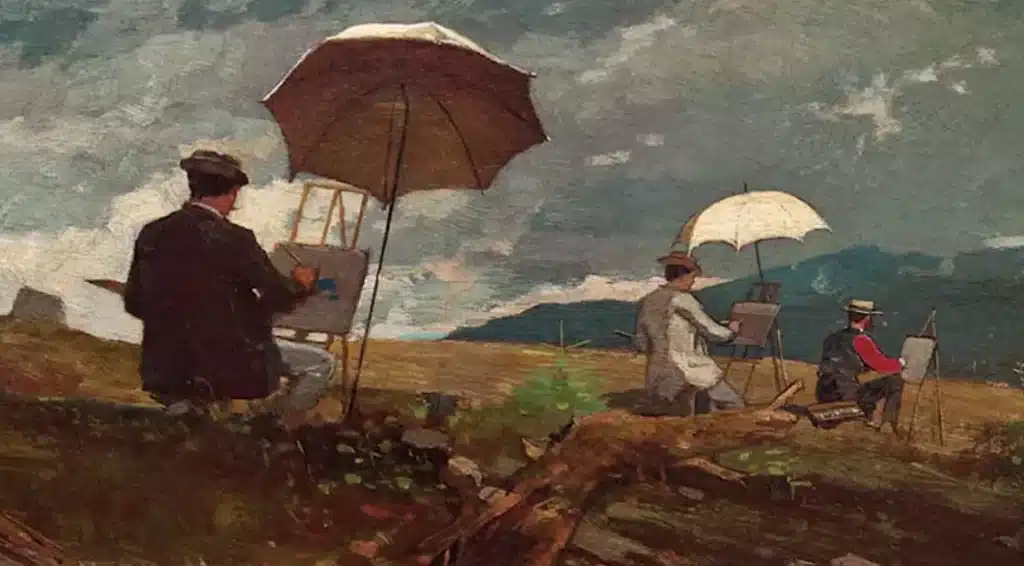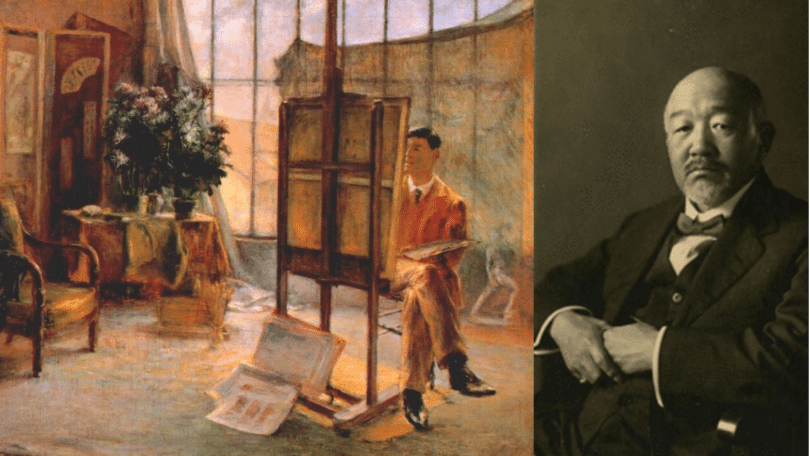Kuroda Seiki played a significant role in the development of modern Japanese art, both through his work and as a teacher at the Tokyo School of Fine Arts. He was a member of several art societies, including the Meiji Bijutsukai and the Hakubakai, and his paintings were exhibited both in Japan and internationally.
Today, Kuroda Seiki is remembered as one of the pioneers of modern Japanese art, and his paintings are highly regarded both in Japan and around the world.
Table of Contents
Who Is Kuroda Seiki?
Kuroda Seiki (1866-1924) was a Japanese painter and one of the most prominent artists of the Meiji period (1868-1912). He is best known for his oil paintings, which were highly influenced by Western styles of art.
Kuroda was born in Kagoshima, Japan, and studied painting at the Tokyo School of Fine Arts. He later went to study in Europe, where he was exposed to Impressionism and other Western painting styles.

Kuroda’s paintings often depicted Japanese landscapes and everyday life, but he approached these subjects with a Western sensibility, using techniques such as light and shadow to create a sense of depth and realism. He was also interested in the human form and created several paintings of nudes.
RELATED: Who is Stefan Banach? Polish mathematician (1892-1945)
Kuroda Seiki’s Biography
Kuroda was born in Takamibaba, Satsuma Domain, which is present-day Kagoshima Prefecture. His father was Kuroda Kiyokane, a samurai of the Shimazu clan, and his mother was Yaeko. At birth, he was named Shintarō, but his name was changed to Seiki when he was 11 years old.
Before his birth, Kuroda’s paternal uncle, Kuroda Kiyotsuna, had chosen him as his heir. In 1871, Kuroda traveled to Tokyo with both his birth mother and adoptive mother to live at his uncle’s estate, where he was formally adopted. Kiyotsuna was a Shimazu retainer who served Emperor Meiji during the Bakumatsu period and at the Battle of Toba-Fushimi, which led to his appointment to high posts in the new imperial government. Because of his position, Kuroda was exposed to modernizing trends and ideas, which he learned and took to heart.
Kuroda began learning English in his early teens in preparation for university studies, but he later switched to French. At 17, he enrolled in pre-college courses in French to prepare for his planned legal studies in college. In 1884, Kuroda’s brother-in-law, Hashiguchi Naouemon, was appointed to the French Legation, and it was decided that Kuroda would accompany him and his wife to Paris to study law. Kuroda arrived in Paris on March 18, 1884, and remained there for the next decade.
Life In Abroad
Kuroda, the oldest son of Kuroda Kiyokane, a samurai of the Shimazu clan, was born on June 29th, 1866 in Takamibaba, Kagoshima city. Even before his birth, Kuroda was to be adopted by his father’s older brother Kiyotsuna. At the age of one, Kuroda traveled to Tokyo with his mother and his new adopted mother, Sadako, and spent his childhood years at Kiyotsuna’s estate in the Hirakawa-cho Kojimachi district of Tokyo.
In his early teens, Kuroda began to study the English language as part of his preparation for entrance to university but then switched to the study of French. At the age of 17, he enrolled in a two-year French course at a school of foreign languages, as he wanted to pursue the study of law in college. In 1884, Kuroda traveled to France with his elder brother-in-law, where he continued to study law. However, a meeting with the painter Yamamoto Hosui, Fuji Masazo, and Hayashi Tadamasa at a gathering of Japanese nationals residing in Paris led Kuroda to abandon his study of law and become a painter instead.
Kuroda spent ten years studying in France until his return to Japan in 1893. During his time in France, Kuroda’s greatest turning point came when he decided to drop his study of law to become a painter. His teacher, Raphael Collin, who had been rising in popularity among the newer members of the Academic styles, played a significant role in his decision.
RELATED: Who are Elvis Presley’s grandchildren? Everything You Need to Know
The origin of painting en plein air.”
In August of the same year that Kuroda entered Collin’s studio, another Japanese man named Kume Keiichiro arrived in Paris. Kume was the eldest son of the historian Kume Kunitake and had studied drawing under Fuji Masazo in Japan. Kume followed Masazo to Paris, where he and Kuroda became close friends and roommates. They both attended Collin’s studio at L’Academie Colarossi, where they learned the standard educational methods of the day for painting. Under this curriculum, students first learned basic drawing skills by copying classical paintings and sketching from sculptures, then they drew from the nude figure and finally painted oil paintings from the human figure and the nude.
They would also study composition from historical paintings and other subjects. Kuroda began to mature as a painter around 1890 after he visited the village of Grez-sur-Loing and settled there to create paintings. This village was home to an artist colony made up of artists from America and Northern Europe, and Kuroda was attracted to this region not only by the beauty of the surrounding scenery but also by the fact that he found in the village a suitable model for his figure work, a young villager named Maria Billault.

Maria is depicted in two of Kuroda’s most famous works from his student years, Woman Reading and Portrait of a Woman. Kuroda became a close friend of Maria’s entire family and rented a small hut on their land for use as his painting studio. Kume remarked that the foreign painters in the artist colony studied the style of Jules Bastien-Lepage, whose farm village paintings with their even-lighted outdoor scenes and so-called plein air sensibility were popular with these foreign artists.
Kuroda’s teacher, Collin, was a friend of Bastien-Lepage, and under Bastien-Lepage’s influence, Collin himself began to bring the expression of external light into his works. Kume describes these foreign artists as “studying the impressionist depictive methods” when they were studying Bastien-Lepage’s style, which was an eclectic blend of academic realism and plein-air expression. Kuroda and Kume also sought this form of expression, which they translated literally into the Japanese term meaning Pleinairism. Examples of Kuroda’s plein air expression can be found in the sere landscape scene Withered Field and in A Girl with Red Hair.
Life In Japan
After years of studying Western-style painting in France, Kuroda returned to Japan eager to apply his skills to the landscapes of his home country. He used plein-air techniques to capture famous sights in Kyoto, such as geisha and ancient temples, in paintings like Maiko and Talk on Ancient Romance. However, Kuroda’s innovative style, heavily influenced by the latest European plein air and Impressionist techniques, shocked Japanese audiences.
His style of bright color tones emphasizing the changes of light and atmosphere was considered revolutionary, inspiring many younger artists to become his students. In 1894, Kuroda inherited the Seikōkan art school from Yamamoto Hōsui, renamed it Tenshin Dōjō, and remodeled its pedagogy to focus on Western precepts and plein-air painting.
Kuroda Seiki’s Career
In 1896, Kuroda’s career was at its peak, and that May he was appointed by Okakura Tenshin, the Dean of the Tokyo School of Fine Arts, as the director of the newly established Department of Western-style Painting. Kuroda embraced his new academic role, despite its emphasis on structure and conformity, and stressed the importance of painting outdoors directly from nature (plein air), including courses in anatomy and live nude model sketching in the curriculum. His ultimate goal was to teach history painting, which he believed had the highest social value, and he created one of his most ambitious works, Talk on Ancient Romance, employing charcoal drawings and oil sketches.
By this time, Kuroda was highly regarded not only in Japan but also in the art world at large. His triptych, Wisdom, Impression, Sentiment, was exhibited alongside his 1897 work, Lakeside, at the Exposition Universelle in Paris in 1900, where it received a silver medal. Lakeside, which depicts Kuroda’s wife Teruko, became his most famous and recognizable work in Japan. It combines elements of European Impressionism, Academicism, and the Barbizon School while emphasizing Japanese subjects.

In 1907, Kuroda and other members of the White Horse Society exhibited in the first Bunten exhibition, sponsored by the Ministry of Education, which led to the disbanding of the group in 1911. Kuroda was appointed a court painter at the Imperial Court in 1910, becoming the first yōga artist to be so honored. From then on, his artistic activities were curtailed, and he became more of a politician and administrator, creating only small works intended for display.
In 1917, he inherited the Kazoku peerage title of viscount on the death of his father and was elected to a seat in the House of Peers in 1920. In 1922, he became the head of the Imperial Fine Arts Academy and was awarded the Grand Cross of the Legion d’Honneur in 1923. Kuroda passed away on July 15, 1924, at his home in Azabu Kōgai-chō, and the Japanese government immediately conferred upon him the Order of the Rising Sun.
His Legacy
Kuroda had an immense influence on Japanese art, both as a painter and a teacher. He was among the pioneers who introduced Western-style painting to a wider Japanese audience, and he imparted the lessons he had learned in Paris to many young artists, such as Wada Eisaku, who would go on to become prominent painters in their own right. Kuroda’s teachings also inspired many students to study in Paris and gain exposure to broader Western art trends, such as Asai Chū, who even drew inspiration from Grez-sur-Loing.
Kuroda’s “Academic Impressionism” style, showcased in paintings like Lakeside (1897) and Lilies (1909), became a dominant force in Japanese art, and it became a fundamental aspect of modern Western-style art education and practice in Japan for many years to come. However, perhaps Kuroda’s most significant contribution to Japanese culture was the wider acceptance of Western-style painting he fostered among the Japanese public. Despite initial skepticism, he convinced people of the validity of Western-style art theories and practices, and this acceptance, along with the honors bestowed upon him later in life, demonstrated a greater recognition of the importance of yōga in Japanese culture.
His Death
Kuroda Seiki passed away on July 15, 1924, at his home in Azabu Kōgai-chō. Immediately upon his death, the Japanese government conferred upon him the Order of the Rising Sun, which was a high honor in recognition of his contributions to Japanese art and culture.













